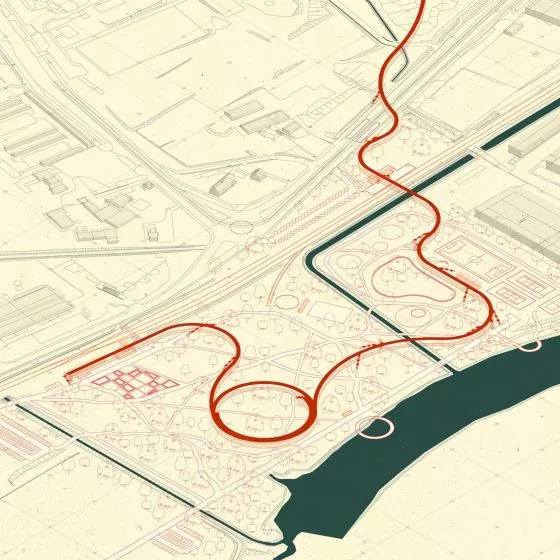We would like to invite Architecture students to participate in a new A&B series - project consultations with famous Polish architects in the pages of our magazine.
Would you like to get advice on your project? For more information, visit www.architekturaibiznes.pl/konsultacje.
"Library of instruments" - project created at the Faculty of Architecture, Cracow University of Technology, academic year: 2020/2021 semester VII
author: Bernadetta Budzik
subject leader: dr. hab. Piotr Gajewski, prof. PK
group leader: Dr. Lukas Olma, MA arch.
The author about the project
"Library of Instruments" is a course project done in the Department of Utility Architecture. The theme of the work was "Sensory Factory," so my project focuses on the use of hearing in the perception of architecture.
"The Library of Instruments" has two underground floors, designed with storage, technical rooms (level -2), instrument lending rooms, a spacious foyer, work spaces and a café (level -1). A bookstore, rehearsal rooms and multi-purpose rooms are planned for the ground and upper floors. The project is located in the center of Krakow, on Kopernika Street.
inspiration for the architectural form
pic: © Author
Due to the assigned topic, when analyzing the plot, I also studied its sound qualities. In addition to the sounds typical of this part of the city, namely cars, vehicles at signals, the noise of renovations and passing trains, the sounds coming from the nearby church stand out. It was the church organ that inspired the architectural form. The use of the unusual shape of the solid allows to achieve better acoustics in the rehearsal rooms, but also involves problems when designing communication and structural solutions. Some of the cylinders are at the same time structural columns that pass through all floors, there are also elements that light up level -1, and in the central part of the projection a cylinder with an additional staircase was designed.
elevation
pic: © Author
In designing, it was also important for me to integrate the site into this part of the city, so a large section of the first floor was raised and used to create an open green space with seating or possible outdoor concerts.
Bernadetta BUDZIK
cross-section
pic: © Author
project author's question
The main problem for me during the design was to figure out how to communicate in the building. I stayed with three staircases, including one technical one, connecting level -1 with the warehouse. It makes me wonder if a more economical solution is possible in terms of the space taken up? - Bernadetta Budzik
architectural consultation
The idea of the Library of Instruments is interesting, but for now a few comments:
- First of all, I very much miss the analysis of the context of the place where the building is to be built. This is one of the most important parts of any project, its complete omission is a big mistake. The hazy silhouettes on the elevation drawing are definitely insufficient. There is no site plan, no bird's eye view, no clear perspectives.
- The lack of analysis of the context does not allow a correct assessment - neither of the form nor of the function of the building. The form seems interesting, but we won't learn from the design how it interacts with its surroundings. We can guess that it will contrast with it, but we should see it, not speculate.
- Inspiration from organ pipes may seem too literal, but when I look at the spatial effect, there is potential for an interesting building.
- Deciding on the original geometry of the main part of the building, based on the wheel projection, we should not juxtapose it with the rather banal form of a broken cuboid. It is neither a proper background nor a counterpoint to the organ-inspired main body. Perhaps the shape of this part is due to the shape of the plot or the shape of the neighboring buildings, but it needs to be shown, justified and properly wonky - so far it's not working.
- I suggest that you try to set your idea in the context of the plot, taking into account public spaces, traffic directions, the shape of neighboring buildings.
- It will be very important to come up with what you will build the form of your building from, what material you will use: brick, concrete, metal, how you will operate the openings and closed surfaces, whether the building will be smooth, shiny, perfect or - which may be even more interesting - rough, rough, imperfect, mossy.
- As for the question about vertical communication - it seems to me that it would definitely be better to run it through the most interesting spaces, rather than relying mainly on closed, standard escape cages. The vertical way should be very attractive, we should impressively sneak past these fancy forms, and not move through the cage like in a block of large slabs. The number of them is secondary - you need to meet the evacuation regulations, keep the proper distances, and that way as many cages as necessary will come out.
I congratulate you on your courage and wish you good luck. Be sure to send, please, the result of your work.
Oskar GRĄBCZEWSKI
Oskar Grąbczewski
Graduate of the Faculty of Architecture at the Silesian University of Technology in Gliwice. Since 2002, together with Barbara Grąbczewska, they have co-founded the OVO Grąbczewscy Architekci studio. Together they have won numerous international and national awards and honors, including the SARP Award of the Year in 2006 and 2016, and were included in the list honoring European architects under 40 - "Europe 40 under 40" in 2009.
















































